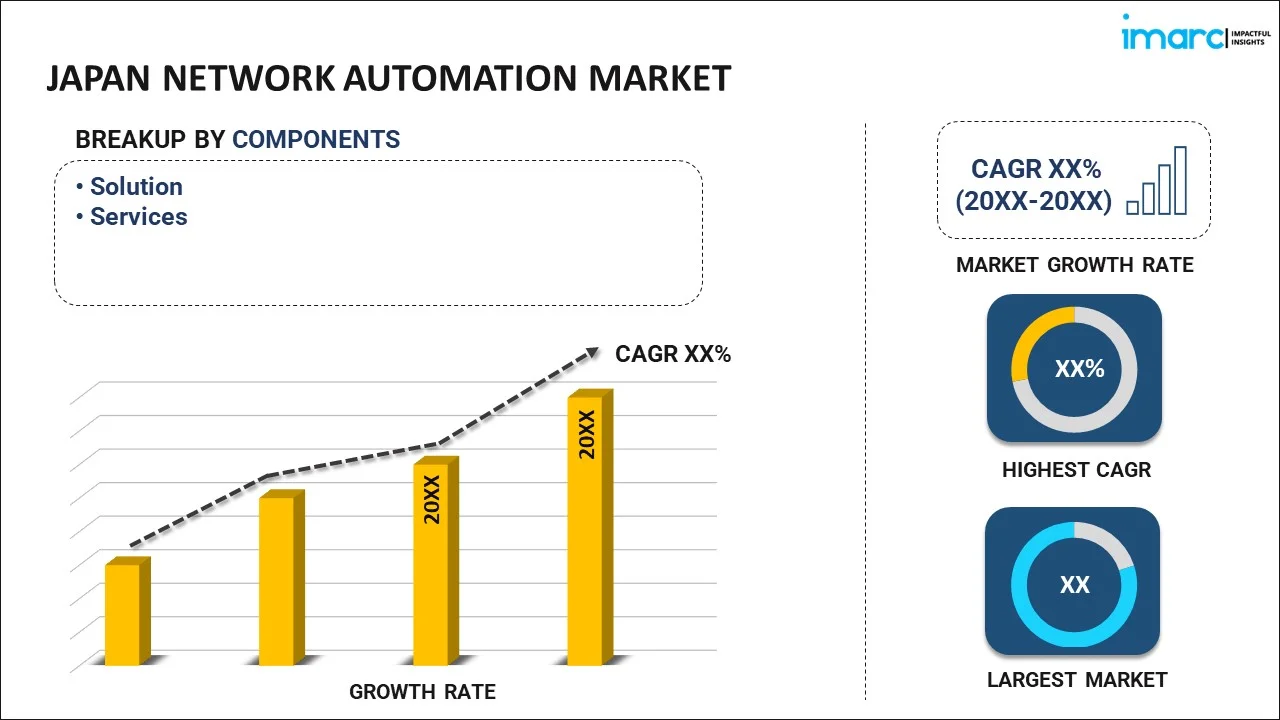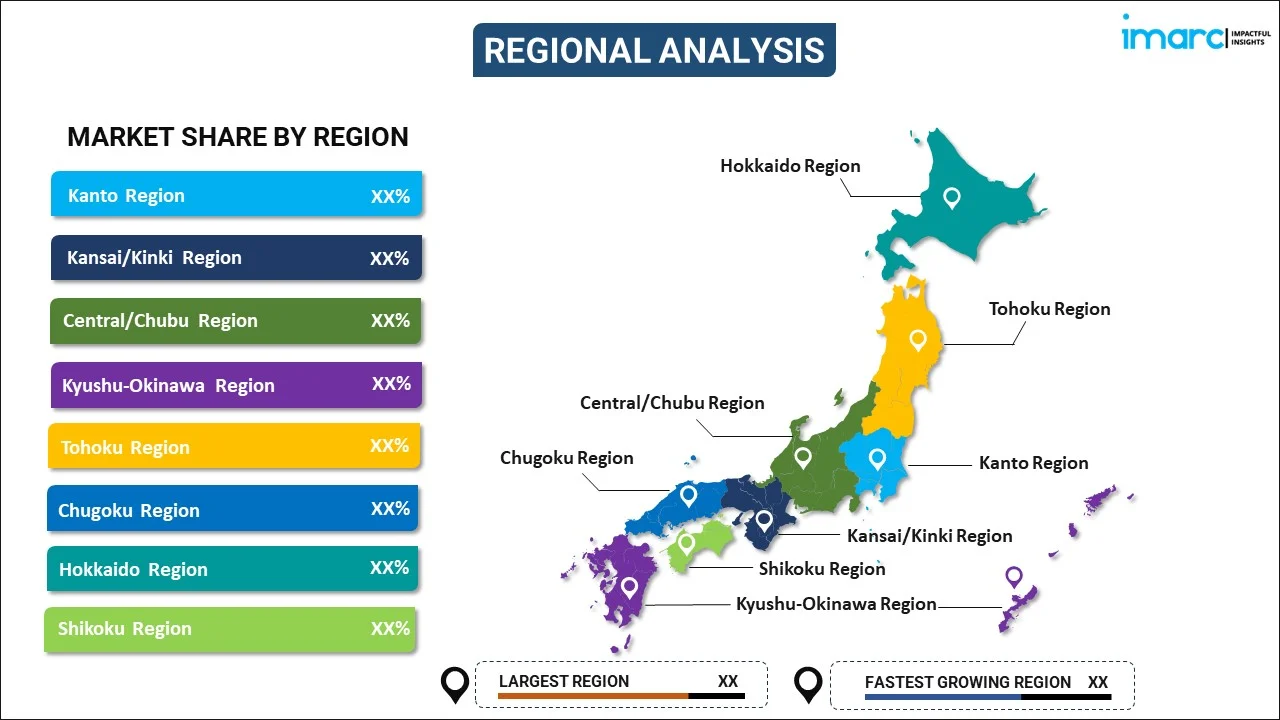
Japan Network Automation Market Report by Component (Solution, Services), Deployment Mode (On-premises, Cloud-based), Organization Size (Large Enterprises, Small and Medium Enterprises), Network Type (Physical, Virtual, Hybrid), End Use Industry (IT and Telecom, Manufacturing, Energy and Utility, Banking and Financial Services, Education, and Others), Region 2025-2033
Market Overview:
Japan network automation market size reached USD 1.6 Billion in 2024. Looking forward, IMARC Group expects the market to reach USD 7.2 Billion by 2033, exhibiting a growth rate (CAGR) of 17.1% during 2025-2033. The increasing prevalence of network complexity with the adoption of new technologies like 5G, IoT, cloud computing, and edge computing, leading to the need for automation, is primarily driving the market.
|
Report Attribute
|
Key Statistics
|
|---|---|
|
Base Year
|
2024
|
|
Forecast Years
|
2025-2033
|
|
Historical Years
|
2019-2024
|
|
Market Size in 2024
|
USD 1.6 Billion |
|
Market Forecast in 2033
|
USD 7.2 Billion |
| Market Growth Rate 2025-2033 | 17.1% |
Network automation is the practice of using software and programmable hardware to streamline and simplify the management and operation of computer networks. It aims to reduce manual intervention in configuring, provisioning, monitoring, and troubleshooting network devices and services. Automation tools and scripts can perform routine tasks like device provisioning, configuration updates, and security policy enforcement more efficiently and consistently than human operators. Key benefits of network automation include increased network reliability, reduced human errors, faster deployment of services, and improved scalability. It also enhances agility by allowing networks to adapt to changing demands and security threats in real time. Network automation relies on technologies such as software-defined networking (SDN), network orchestration, and scripting languages like Python. By abstracting network tasks into code and templates, organizations can achieve greater control over their infrastructure, optimize resource utilization, and respond more effectively to evolving business requirements, ultimately driving operational efficiency and cost savings.
Japan Network Automation Market Trends:
The network automation market in Japan is experiencing rapid growth due to several key drivers. Firstly, the increasing complexity of networks, coupled with the demand for faster service delivery, has led organizations to seek automation solutions. Consequently, network automation offers the means to streamline operations and reduce manual errors, thereby enhancing network efficiency. Moreover, the surge in data traffic and the advent of technologies like 5G has created a pressing need for network scalability and agility. As a result, network automation is viewed as a strategic enabler to meet these evolving demands. Additionally, the rise of cloud computing and hybrid environments necessitates seamless network provisioning and management, further propelling the adoption of automation solutions. Apart from this, cost reduction remains a paramount concern for businesses, and automation's potential for reducing operational expenses through resource optimization and error reduction is a compelling driver. Additionally, the escalating incidences of cybersecurity threats, with the rising importance of network security and compliance, are expected to drive the network automation market in Japan during the forecast period.
Japan Network Automation Market Segmentation:
IMARC Group provides an analysis of the key trends in each segment of the market, along with forecasts at the country level for 2025-2033. Our report has categorized the market based on component, deployment mode, organization size, network type, and end use industry.
Component Insights:

- Solution
- Network Automation Tools
- SD-WAN and Network
- Virtualization
- Internet-Based Networking
- Services
- Professional Service
- Managed Service
The report has provided a detailed breakup and analysis of the market based on the component. This includes solution (network automation tools, SD-WAN and network, virtualization, and internet-based networking), and services (professional service and managed service).
Deployment Mode Insights:
- On-premises
- Cloud-based
A detailed breakup and analysis of the market based on the deployment mode have also been provided in the report. This includes on-premises and cloud-based.
Organization Size Insights:
- Large Enterprises
- Small and Medium Enterprises
The report has provided a detailed breakup and analysis of the market based on the organization size. This includes large enterprises and small and medium enterprises.
Network Type Insights:
- Physical
- Virtual
- Hybrid
A detailed breakup and analysis of the market based on the network type have also been provided in the report. This includes physical, virtual, and hybrid.
End Use Industry Insights:
- IT and Telecom
- Manufacturing
- Energy and Utility
- Banking and Financial Services
- Education
- Others
The report has provided a detailed breakup and analysis of the market based on the end use industry. This includes IT and telecom, manufacturing, energy and utility, banking and financial services, education, and others.
Regional Insights:

- Kanto Region
- Kansai/Kinki Region
- Central/ Chubu Region
- Kyushu-Okinawa Region
- Tohoku Region
- Chugoku Region
- Hokkaido Region
- Shikoku Region
The report has also provided a comprehensive analysis of all the major regional markets, which include Kanto Region, Kansai/Kinki Region, Central/ Chubu Region, Kyushu-Okinawa Region, Tohoku Region, Chugoku Region, Hokkaido Region, and Shikoku Region.
Competitive Landscape:
The market research report has also provided a comprehensive analysis of the competitive landscape. Competitive analysis such as market structure, key player positioning, top winning strategies, competitive dashboard, and company evaluation quadrant has been covered in the report. Also, detailed profiles of all major companies have been provided.
Japan Network Automation Market Report Coverage:
| Report Features | Details |
|---|---|
| Base Year of the Analysis | 2024 |
| Historical Period | 2019-2024 |
| Forecast Period | 2025-2033 |
| Units | Billion USD |
| Scope of the Report | Exploration of Historical and Forecast Trends, Industry Catalysts and Challenges, Segment-Wise Historical and Predictive Market Assessment:
|
| Components Covered |
|
| Deployment Modes Covered | On-premises, Cloud-based |
| Organization Sizes Covered | Large Enterprises, Small and Medium Enterprises |
| Network Types Covered | Physical, Virtual, Hybrid |
| End Use Industries Covered | IT and Telecom, Manufacturing, Energy and Utility, Banking and Financial Services, Education, Others |
| Regions Covered | Kanto Region, Kansai/Kinki Region, Central/ Chubu Region, Kyushu-Okinawa Region, Tohoku Region, Chugoku Region, Hokkaido Region, Shikoku Region |
| Customization Scope | 10% Free Customization |
| Post-Sale Analyst Support | 10-12 Weeks |
| Delivery Format | PDF and Excel through Email (We can also provide the editable version of the report in PPT/Word format on special request) |
Key Questions Answered in This Report:
- How has the Japan network automation market performed so far and how will it perform in the coming years?
- What has been the impact of COVID-19 on the Japan network automation market?
- What is the breakup of the Japan network automation market on the basis of component?
- What is the breakup of the Japan network automation market on the basis of deployment mode?
- What is the breakup of the Japan network automation market on the basis of organization size?
- What is the breakup of the Japan network automation market on the basis of network type?
- What is the breakup of the Japan network automation market on the basis of end use industry?
- What are the various stages in the value chain of the Japan network automation market?
- What are the key driving factors and challenges in the Japan network automation?
- What is the structure of the Japan network automation market and who are the key players?
- What is the degree of competition in the Japan network automation market?
Key Benefits for Stakeholders:
- IMARC’s industry report offers a comprehensive quantitative analysis of various market segments, historical and current market trends, market forecasts, and dynamics of the Japan network automation market from 2019-2033.
- The research report provides the latest information on the market drivers, challenges, and opportunities in the Japan network automation market.
- Porter's five forces analysis assist stakeholders in assessing the impact of new entrants, competitive rivalry, supplier power, buyer power, and the threat of substitution. It helps stakeholders to analyze the level of competition within the Japan network automation industry and its attractiveness.
- Competitive landscape allows stakeholders to understand their competitive environment and provides an insight into the current positions of key players in the market.
Need more help?
- Speak to our experienced analysts for insights on the current market scenarios.
- Include additional segments and countries to customize the report as per your requirement.
- Gain an unparalleled competitive advantage in your domain by understanding how to utilize the report and positively impacting your operations and revenue.
- For further assistance, please connect with our analysts.
 Inquire Before Buying
Inquire Before Buying
 Speak to an Analyst
Speak to an Analyst
 Request Brochure
Request Brochure
 Request Customization
Request Customization




.webp)




.webp)












